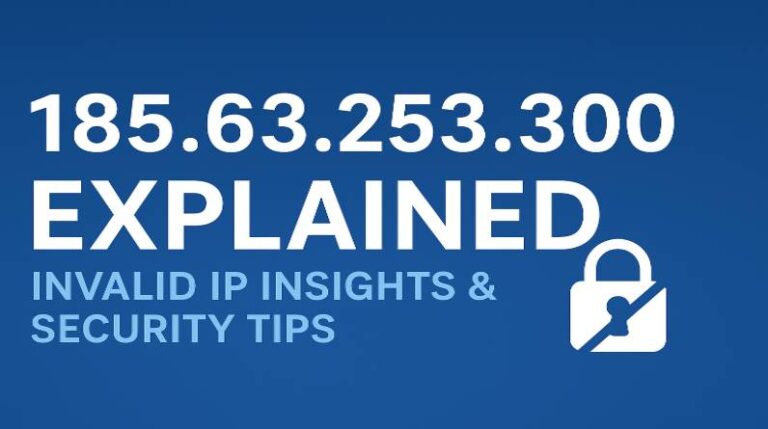In the vast landscape of the internet, IP addresses are the unsung heroes that keep digital communication running smoothly. Among these, 185.63.253.300 has emerged as a curious case that has captured the attention of IT professionals, cybersecurity enthusiasts, and curious internet users alike. While this address is technically invalid, exploring its nuances offers fascinating insights into how IP addresses work, why invalid addresses matter, and what lessons they hold for cybersecurity and network management.
What Is an IP Address?
An IP (Internet Protocol) address is essentially a digital identifier for every device connected to a network. Just as a postal address allows mail to reach the right home, an IP address allows data to reach the correct computer, server, or device on the internet.
Types of IP Addresses
- IPv4 (Internet Protocol version 4)
- Uses four sets of numbers separated by dots (e.g., 192.168.0.1)
- Each number ranges from 0 to 255
- Supports approximately 4.3 billion unique addresses
- IPv6 (Internet Protocol version 6)
- Uses longer alphanumeric addresses (e.g., 2001:0db8:85a3:0000:0000:8a2e:0370:7334)
- Supports trillions of unique addresses, future-proofing the internet
185.63.253.300 follows an IPv4-style format but contains a number (300) outside the valid range, making it an invalid address.
Breaking Down 185.63.253.300
Let’s dissect this address to understand why it cannot exist in real-world networking:
| Octet | Value | Valid Range | Status |
| 1 | 185 | 0–255 | ✅ Valid |
| 2 | 63 | 0–255 | ✅ Valid |
| 3 | 253 | 0–255 | ✅ Valid |
| 4 | 300 | 0–255 | ❌ Invalid |
The final octet exceeding 255 violates the core rules of IPv4 addressing. While it cannot be assigned to a real device, it frequently appears in discussions, logs, and cybersecurity case studies as a teaching or testing example.
Why 185.63.253.300 Appears in the Digital World
Despite being invalid, this IP shows up in various contexts:
- Typographical Errors: Users may accidentally type or log extra digits.
- Placeholder in Documentation: Often used in IT training or scripts to illustrate examples.
- Test Environments: Developers use fake IPs to simulate traffic without connecting to real servers.
- Malicious Obfuscation: Hackers sometimes insert invalid IPs in logs to hide real activity or mislead analysts.
Security Implications of Invalid IPs
While 185.63.253.300 cannot connect to a real server, invalid IPs can still have security relevance:
- Log Confusion: Fake or malformed IPs may appear in server logs, complicating threat analysis.
- Malware Evasion: Bots or malware may use invalid IPs to disguise source addresses.
- Testing Vulnerabilities: Researchers often insert invalid IPs into systems to monitor firewall behavior or test IDS/IPS rules.
Example Scenario
Imagine a small business firewall receiving multiple connection attempts from 185.63.253.300. A network admin might initially suspect intrusion. Upon investigation, they discover it’s a misconfigured test from an internal security audit. This highlights the importance of context-aware monitoring.
How to Verify an IP Address
If you encounter an unfamiliar IP like 185.63.253.300, here are steps to assess its validity:
- Check Octet Ranges – Ensure each number is between 0–255.
- Ping the Address – Invalid IPs will not respond.
- WHOIS Lookup – Reveals ownership details for valid IPs (e.g., ISP, organization, country).
- Reverse DNS Lookup – Converts IPs to domain names if valid.
By following these steps, IT professionals can separate harmless placeholders from potentially malicious activity.
Common Mistakes with IP Addresses
Many users unknowingly create invalid IPs due to:
- Adding extra digits (e.g., 185.63.253.300 instead of 185.63.253.30)
- Mixing up IPv4 and IPv6 formats
- Misplacing dots or using spaces instead
- Confusing public IPs with private IPs
Awareness of these pitfalls can prevent network misconfigurations and connectivity issues.
Alternatives and Safe Practices
If you encounter or need to assign an IP, consider valid alternatives:
- 63.253.30 – Could be a valid European server IP
- 63.253.3 – Likely used in internal networks or test labs
- 63.253.200 – Another valid public IP
Safety Tips for Handling IPs:
- Use VPNs to protect your real IP
- Monitor logs for unusual patterns
- Update firewalls and IDS regularly
- Treat unknown IPs cautiously, validating before blocking
IP Addresses and Cybersecurity
IP addresses are fundamental in cybersecurity for:
- Blocking Threats: Firewalls and security tools often use IPs to restrict malicious access.
- Monitoring Activity: Security dashboards track suspicious behavior by IP.
- Whitelisting Trusted Devices: Ensures only authorized IPs access sensitive systems.
Even an invalid IP like 185.63.253.300 can teach lessons about traffic monitoring, anomaly detection, and digital hygiene.
The Psychological Factor: Why People Are Curious About 185.63.253.300
This IP has gained attention not because of real-world activity, but due to human curiosity:
- It Looks Real: The format closely resembles a legitimate IPv4 address.
- Mystery Drives Searches: People naturally investigate anomalies in server logs or online discussions.
- Learning Tool: IT students and beginners often use it to understand valid vs invalid addresses.
Understanding these patterns highlights how education and curiosity intersect with cybersecurity awareness.
Invalid IPs as a Teaching Tool
Most guides focus on technical validation or security risks. However, 185.63.253.300 also serves as a case study in human-computer interaction and system design:
- Error Handling: Shows how systems respond to invalid input.
- UI/UX Lessons: Good network tools should alert users when IPs are malformed.
- Cognitive Awareness: Users learn the limits of IPv4 and the importance of precision.
By framing invalid IPs as educational tools, organizations can improve training, reduce errors, and enhance cybersecurity readiness.
Conclusion
While 185.63.253.300 cannot exist as a functioning IPv4 address, it provides valuable lessons in networking, cybersecurity, and digital literacy. From illustrating common errors to highlighting how invalid data appears in logs, this address serves as a unique lens through which we can explore the mechanics of the internet.
By understanding its nuances, users can:
- Better validate IP addresses
- Improve network security monitoring
- Avoid common mistakes in IT and coding
- Appreciate the precision required in digital communication
FAQs:
- Is 185.63.253.300 a valid IP address?
No, the last segment “300” exceeds the IPv4 limit of 255, making it invalid. - Why does 185.63.253.300 appear online?
It may appear due to typos, placeholders in documentation, test environments, or as examples for learning. - Can 185.63.253.300 be used to access a server?
No, invalid IPs cannot be assigned to devices and cannot route traffic on the internet. - Could hackers use fake IPs like 185.63.253.300?
Yes, fake IPs can be used in logs, phishing, or obfuscation, but this specific IP cannot connect anywhere. - How can I verify if an IP address is valid?
Check that each segment is between 0–255, use ping tests, WHOIS lookup, or reverse DNS tools. - What should I do if I see 185.63.253.300 in server logs?
Don’t panic; it could be a typo or test entry. Investigate log sources and monitor for patterns before taking action. - Are invalid IPs relevant to cybersecurity?
Yes, they help identify misconfigurations, test firewalls, and teach traffic validation in IT security training.
For more insightful articles and the latest updates, keep visiting Hacoo.

